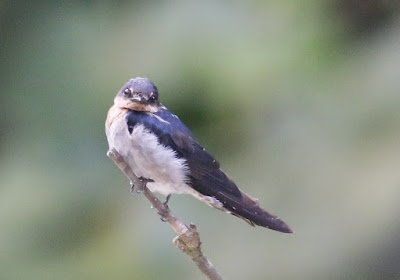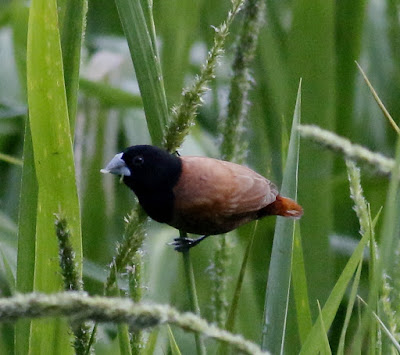The recent sightings of 3 mega birds by Noah Strycker here had activated my curiosity hormone yet again. I have planned to reach the location at the same time as his but was caught up a bit in the morning rush hour. It was about 8.00am by the time i set foot at the site and immediately i scanned the area which was still dark. After an hour i gave up but i did saw some birds for the very first time (first time here unfortunately did not mean a lifer but more of a first sighting of such birds at this location by myself). Let me start with the winter visitors.
 |
| Korean Flycatcher aka Yellow-Rumped Flycatcher |
This flycatcher had remained silent through out. Not a single whisper.
 |
| Gray Wagtail |
It looks like it has a tinge of yellow on its supercilium which resulted of me thinking that it could be a "flavissima" initially. Luckily Dave Bakewell has corrected its i.d before i could raised more unfortunate eyebrows.
This bird is believed to be a Siberian Blue Robin - probably a juvenile. If the i.d is positive then it looks like we do not have to travel up to highlands anymore to see this bird species.
 |
| Eastern Crowned Leaf Warbler |
This was the first time i have heard an Eastern Crowned Leaf Warbler calls which i believed was more of an alarm call rather than a song. Unfortunately i was too engrossed to take its photos than to record its calls.
You can see the faint stripe on its crown.
Here are some of the local birds seen.
 |
| Chestnut-Naped Forktail |
The current raining season had raised the water level in the streams which might have resulted in this bird to forage outside its usual habitat. Despite her striking colors it was actually well camouflaged among the jungle litter.
OK i had enough. Time to run.
This is a Crimson-Winged Woodpecker !
 |
| Checker Throated Woodpecker |
Ha ! caught you there.
 |
| Olive-Backed Woodpecker |
It was lying low as the Wallace Hawk Eagle was seen flying just above the tree canopies.
A look at a Buff-Rumped Woodpecker from the back.
 |
| Chestnut-Breasted Malkoha - male |
I was really glad to see this malkoha again.
 |
| Little Spiderhunter |
This usually noisy Little Spiderhunter had remained silent too.
 |
| Tickell's Blue Flycatcher - male |
Some parts of this jungle was so well covered that sometimes you might just have to use a flash lite even at 11.00am !
Could this finally be Taylor Swift? In my wildest dream i guess.
 |
| Gray-Rumped Treeswift |
This Purple-Naped Sunbird was trying to do a humming bird stunt.
Initially i thought i might have seen a lifer.
But it just turned out to be a male Lesser Cuckooshrike. Anyway its not everyday that you would see a male lesser cuckooshrike if you do agree with me.
Note its color which looks more like some Philentoma rather than dark greyish colors as depicted by some field guides.
In poor light and thick foliage, these white-rumped munia can be easily mistaken as a dusky munia if you are not careful enough.
HAPPY BIRD WATCHING !










































